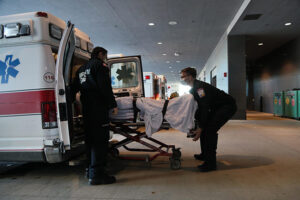DECEMBER 2, 2023

EMTs transfer a patient in the busy ambulance bay at UMass Memorial Medical Center in Worcester, Md., on Dec. 12. The hospital is operating at above its normal capacity because of a surge in a variety of illnesses like RSV, flu, and COVID. – Suzanne. Kreiter/The Boston Globe via Getty Images
COVID will likely reach levels this winter not yet seen this year, combining with surges of flu, RSV, and other pathogens for a “syndemic” winter not so different from last year’s “tripledemic,” experts say.
Raj Rajnarayanan, assistant dean of research and associate professor at the New York Institute of Technology campus in Jonesboro, Ark., told Fortune that the U.S. is a “sitting duck” in the face of a “syndemic” winter.
It’s a term he prefers to “tripledemic,” as it recognizes the impact of more than three pathogens on the healthcare system, and the need for policies to address the phenomenon, in addition to medical interventions.
“Strained hospital capacities, workforce exhaustion, burnout, a lack of effective therapeutic tools, poor communication, and lack of compliance [with COVID precautions], a lack of continuity planning, and the pervasive influence of social determinants of health” only make the nation’s delicate health infrastructure more fragile, he said.
COVID wastewater levels are “high” and again headed upwards, on track to surpass their 2023 peak, which occurred in September, according to wastewater data posted by the U.S. Centers for Disease Control and Prevention. COVID hospitalizations are up 10% week over week, according to the most recent data made available. And deaths, while not rising, are not receding, either.
JP Weiland—a top COVID forecaster cited by leading public health experts like Dr. Eric Topol—told Fortune he has “little doubt” that this winter’s COVID wave will be the highest the country has seen since last winter, when Omicron spawn XBB.1.5 “Kraken” sent cases rocketing skyward yet again.
There’s a “reasonable chance” it surpasses that of last year, he added—but little chance it competes with the initial Omicron peak of the 2021-2022 winter, when U.S. infections hit an all-time high.
Meanwhile, U.S. rates of hospitalization from RSV and flu are also on the rise, and outpatient visits for respiratory illnesses are abnormally high, according to CDC data.
“Last year really showed what happens when we go a few years without seeing our normal viral trends,” Dr. Karen Acker, pediatric infectious diseases specialist at New York Presbyterian Komansky Children’s Hospital, told Fortune on Friday.
She was referencing the “immunity debt” theory, according to which infections from other pathogens spike after pandemic precautions are abandoned. Some blame the potential phenomenon for last year’s relatively severe winter respiratory disease season, which challenged hospital capacity in many locations.
“It may take some time for viral levels and the immunity dynamic to level out,” she added. “This may be another bad year.”
Flu surging, RSV ‘near peak’
Encouragingly, while U.S. rates of hospitalization from COVID, RSV, and flu combined are on the rise, they remain below levels seen this time of year during the past two years. Still, they’re significantly higher than that seen in the two winters prior to the COVID-19 pandemic.
RSV hospitalizations are the highest they’ve been since 2020, with exception of last winter. And flu hospitalizations, with the exception of last year, are the highest they’ve been at this time of year since 2017, when they were identical.
CDC Director Dr. Mandy Cohen on Thursday said U.S. flu season, while so far typical, is “accelerating fast,” and that RSV is “near peak,” in testimony before the House Energy and Commerce Subcommittee on Oversight and Investigations.
Multiple experts told Fortune that this winter’s respiratory season should more closely resemble pre-pandemic years than last year’s, though it may take several years for typical seasonal viral patterns to reestablish.
Dr. Amesh Adalja, an infectious disease specialist and senior scholar at the Johns Hopkins Center for Health Security, told Fortune he expects a more standard season this year, “with the exception that COVID-19 will remain a major force that impacts hospitalizations and death numbers.”
He expects the usual mix of COVID, flu, rhinovirus, metapneumovirus, RSV, adenovirus, and seasonal coronavirus, with most of the latter presenting as common colds.
It’s possible, but uncertain, that the U.S. sees a surge in cases of mycoplasma pneumoniae, an atypical bacteria that can cause lung infection, experts say. Such a surge is reportedly occurring in China among youth, in addition to the Netherlands, Denmark, France, and Ireland.
Dr. Stuart Ray, vice chair of medicine for data integrity and analytics at Johns Hopkins’ Department of Medicine, doesn’t have “strong sense that this will be a particularly bad” respiratory season, he said. “But it’s awfully hard to predict the future when it comes to respiratory pathogens, as we’ve learned in recent years,” he added.
A recent U.K. case of a strain of swine flu new to humans “illustrates the uncertainties we always face on this topic,” Ray said. Officials with the World Health Organization on Friday said the sickened individual, who has recovered, lives close to pigs but had no contact with them, and that “limited human-to-human transmission may have played a role,” though there is “no definitive evidence.”
While Ray doesn’t see the particular strain of swine flu posing a larger threat to humans at this time, “something like that is always looming as a possibility,” he said.
COVID a continued wildcard
Of the three main winter respiratory pathogens—COVID, flu, and RSV—COVID remains the greatest threat this season, Cohen told Congress on Thursday. It’s “still the respiratory virus putting the most number of folks in the hospital and taking lives,” she said.
Experts are eyeing variant “Pirola” BA.2.86 and its descendents like JN.1 in particular, saying their fast rate of spread could exacerbate an already expected winter COVID surge.
Already, BA.2.86 and descendents are thought to be behind around 9% of COVID cases in the U.S.—ranking third in the race for viral supremacy and lagging “Eris” EG.5 by only a few percentage points, according to CDC data released this past week.
The viral family also comprises about 9% of sequences reported globally over the last month, with levels doubling each week for the past four weeks, according to a recent update from the World Health Organization. Last week it upgraded BA.2.86 and descendents to a variant of interest of global proportions—second only to the category of variant of concern. And the CDC released a statement on the variant, saying it expects BA.2.86 and descendents to continue growing in the U.S., and calling out JN.1 as a variant with particular potential to take off.
While BA.2.86 and descendents aren’t thought to cause more severe disease than other Omicron variants, according to the WHO, a greater-than-expected surge in cases would still pressure an already fragile U.S. healthcare system, experts say.
‘Immunity debt’ one of several theories
While some point to the immunity debt theory as the driver behind wonky post-pandemic viral seasons, some experts say other theories should be considered. Among them: that COVID suppresses the immune system—at least temporarily, and at least in some—making them more susceptible to other infections.
Another: that being infected with both COVID and another pathogen at the same time makes the other pathogen, like RSV, more severe.
Rajnarayanan points to a recent article in the British Medical Journal, the findings of which suggest that COVID contributed to last year’s surge of RSV cases “through the large buildup of COVID-19 infected children and the potential long-term adverse effects of COVID-19 on the immune and respiratory system.”
“Immunity debt is one hypothesis,” Ryan Gregory, a biology professor at the University of Guelph in Ontario, Canada, told Fortune. But “the consequences of getting the answer wrong requires us to test all available explanations and not to be content with making assumptions because an explanation sounds plausible.”
Regardless of how we got here, increased exposure to viruses after a period of decreased exposure—to pay the so-called immunity debt—isn’t helping anyone, he said.
“There is no circumstance in which more viruses circulating is a good thing,” he said. “Whether COVID, flu, or RSV put people in the hospital, whether they acquire one of those while in the hospital for some other reason, or whether they have one or more of those in addition to whatever led to them being hospitalized, it’s bad.”
Courtesy: This story was originally featured on Fortune.com










































































































